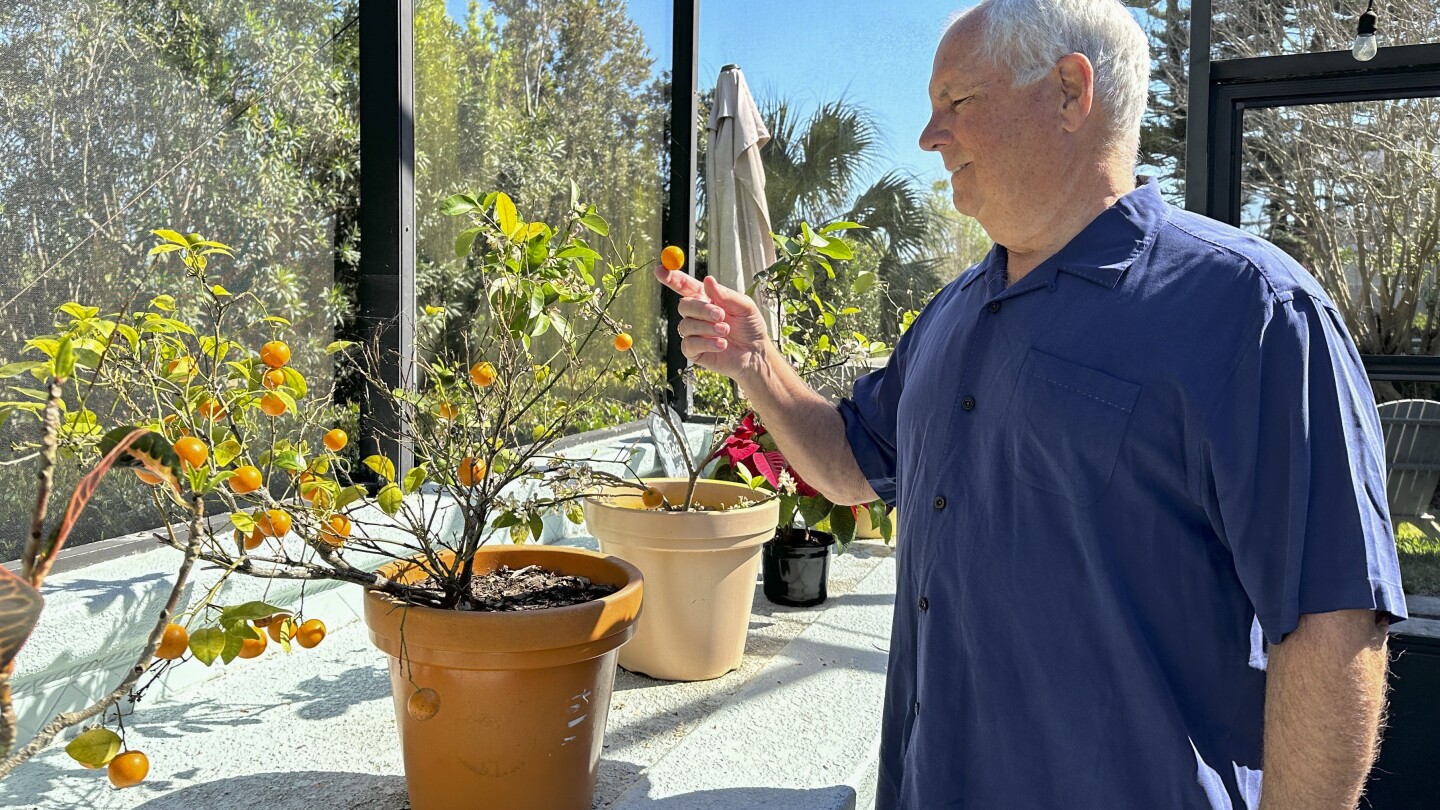Lifestyle
How a touristy Florida beach town became a top US remote work hub

ST. AUGUSTINE, Fla. (AP) — Lori Matthias and her husband had tired of Atlanta traffic when they moved to St. Augustine, Florida, in 2023. For Mike Waldron and his wife, moving from the Boston area in 2020 to a place that bills itself as “the nation’s oldest city” was motivated by a desire to be closer to their adult children.
They were among thousands of white-collar, remote workers who migrated to the St. Augustine area in recent years, transforming the touristy beach town into one of the top remote work hubs in the United States.
Matthias fell in love with St. Augustine’s small town feeling, trading the hour-long commute she had in Atlanta for bumping into friends and acquaintances while running errands.
“The whole pace here is slower and I’m attracted to that,” said Matthias, who does sales and marketing for a power tool company. “My commute is like 30 steps from my kitchen to my office. It’s just different. It’s just relaxed and friendly.”
Centuries before becoming a remote work hub, the St. Augustine area was claimed by the Spanish crown in the early 16th century after explorer Juan Ponce de Leon’s arrival. In modern times, it is best known for its Spanish architecture of terra cotta roofs and arched doorways, tourist-carrying trollies, a historic fort, an alligator farm, lighthouses and a shipwreck museum.
A population boom driven by the pandemic
In St. Johns County, home to St. Augustine, the percentage of workers who did their jobs from home nearly tripled from 8.6% in 2018 to almost 24% in 2023, moving the northeast Florida county into the top ranks of U.S. counties with the largest share of people working remotely, according to U.S. Census Bureau figures.
Only counties with a heavy presence of tech, finance and government workers in metro Washington, Atlanta, Austin, Charlotte and Dallas, as well as two counties in North Carolina’s Research Triangle, had a larger share of their workforce working from home. But these were counties much more populous than the 335,000 residents in St. Johns County, which has grown by more than a fifth during this decade.
Scott Maynard, a vice president of economic development for the county’s chamber of commerce, attributes the initial influx of new residents to Florida’s lifting of COVID-19 restrictions in businesses and schools in the fall of 2020 while much of the country remained locked down.
“A lot of people were relocating here from the Northeast, the Midwest and California so that their children could get back to a face-to-face education,” Maynard said. “That brought in a tremendous number of people who had the ability to work remotely and wanted their children back in a face-to-face school situation.”
Public schools in St. Johns County are among the best in Florida, according to an annual report card by the state Department of Education.
Surging popularity comes at a price
The influx of new residents has brought growing pains, particularly when it comes to affordable housing since many of the new, remote workers moving into the area are wealthier than locals and able to outbid them on homes, officials said.
Many essential workers such as police officers, firefighters and teachers have been forced to commute from outside St. Johns County because of rising housing costs. The median home price grew from $405,000 in 2019 to almost $535,000 in 2023, according to Census Bureau figures, making the purchase of a home further out of reach for the county’s essential workers.
Essential workers would need to earn at least $180,000 annually to afford the median price of a home in St. Johns County, but a teacher has an average salary of around $48,000 and a law enforcement officer earns around $58,000 on average, according to an analysis by the local chamber of commerce.
“What happened was a lot of the people, especially coming in from up North, were able to sell their homes for such a high value and come here and just pay cash since this seemed affordable to them,” said Aliyah Meyer, an economic researcher at the chamber of commerce. “So it kind of inflated the market and put a bit of a constraint on the local residents.”
Waldron, a sales executive in the health care industry, was able to sell his Boston home at the height of the pandemic and purchase a three-bedroom, two-bath home in a gated community by a golf course outside St. Augustine where “things really worked out to be less expensive down here.”
The flexibility offered by fast wireless internet and the popularity of online meeting platforms since the start of the pandemic also helped.
“If I was still locked in an office, I would not have been able to move down here,” Waldron said.
___
Follow Mike Schneider on the social platform Bluesky: @mikeysid.bsky.social
Lifestyle
Queen Elizabeth II’s favorite dog breed race for glory in the UK’s Corgi Derby

LONDON (AP) — Some of the fastest canines on four very short legs have raced for glory in Scotland’s annual Corgi Derby.
The Musselburgh Racecourse Corgi Derby was first held in 2022 to mark Queen Elizabeth II’s 70 years on the throne. The late monarch was a devoted corgi fan who owned almost 30 of the breed over the decades, along with a few dorgis – a corgi-dachshund cross.
Four-year-old Juno beat a 16-strong field of dashing dogs dressed in bright sweaters over the 230-foot (70-meter) race on Saturday at the racecourse outside Edinburgh. She came from behind in the final stretch to beat last year’s winner, Rodney.
The winner and her owners, Alisdair Tew and Fran Brandon, were presented with a trophy and dog treats by tennis coach Judy Murray, mother of Scottish star Andy Murray.
Tew told the BBC that “we trained her for this last year but this year we just resorted to just letting her chasing things, particularly seagulls” on Edinburgh’s Portobello Beach.
“Juno is always ready for treats -– that is probably why she won,” he said.
Elizabeth’s love of corgis began in 1933 when her father, King George VI, brought home a Pembroke Welsh corgi they named Dookie
Corgis were often by Elizabeth’s side in the decades before her death in September 2022 — accompanying her on official tours, reportedly sleeping in their own room at Buckingham Palace and occasionally nipping the ankles of visitors or royal family members.
Three corgis even appeared alongside the queen as she climbed into James Bond’s waiting helicopter in the spoof video that opened the 2012 London Olympics.
Lifestyle
Famed Sherpa guide will attempt to climb Mount Everest for a 31st time and break his own record

KATHMANDU, Nepal (AP) — One of the greatest mountain guides will attempt to scale the world’s highest peak for the 31st time — and possibly the 32nd time as well — and break his own record.
Kami Rita, 55, flew to Mount Everest on Sunday from Kathmandu to lead a group of climbers who will try to reach the 8,849-meter (29,032-foot) summit during the spring climbing season.
“I am mentally, emotionally and physically prepared to climb the mountain,” Kami Rita told The Associated Press at Kathmandu’s airport. “I am in my top physical condition right now.”
He holds the record for the most successful ascents of Mount Everest at 30 times. In May last year he climbed the peak twice.
“My first priority is to get my client to the summit of the peak. Then I will decide on whether I will climb the peak more than one time during the season. It depends on the weather and conditions on the mountain,” he said.
His closest competitor for the most climbs of Mount Everest is fellow Sherpa guide Pasang Dawa, who has made 27 successful ascents of the mountain.
Kami Rita first climbed Everest in 1994 and has been making the trip nearly every year since. He is one of many Sherpa guides whose expertise and skills are vital to the safety and success each year of foreign climbers aspiring to stand on top of the mountain.
His father was among the first Sherpa mountain guides. In addition to his Everest climbs, Kami Rita has scaled several other peaks that are among the world’s highest, including K2, Cho Oyu, Manaslu and Lhotse.
According to Nepal’s Department of Tourism, 214 climbers have been issued permits to attempt Mount Everest from the Nepali side of the peak in the south this climbing season, which ends in May. Most climbing of Everest and nearby Himalayan peaks is done in April and May, when weather conditions are most favorable.
Everest was first climbed in 1953 by New Zealander Edmund Hillary and Nepali Sherpa Tenzing Norgay.
Lifestyle
Marijuana holiday 4/20 coincides with Easter and Passover this year. Here’s what to know

Marijuana culture’s high holiday, known as 4/20, falls this year on Easter Sunday, as well as the last day of Passover, meaning cannabis fans can celebrate in some unusual ways, including an “Easter nug hunt” in Los Angeles, kosher-style THC gummies in New York and a “blaze and praise” drag brunch in Portland, Oregon.
“It seemed appropriate with egg prices today that we’d be searching for something else,” said Brett Davis, who runs the marijuana tour company Weed Bus Los Angeles and organized the “Easter nug hunt.”
Here’s a look at 4/20’s history and how it’s being celebrated this year:
Why 4/20?
The origins of the date, and the term “420” generally, were long murky.
Some claimed it referred to a police code for marijuana possession or was derived from Bob Dylan’s “Rainy Day Women No. 12 & 35,” with its refrain of “Everybody must get stoned,” 420 being the product of 12 times 35.
But the prevailing explanation is that it started in the 1970s with a group of bell-bottomed buddies from San Rafael High School, in California’s Marin County north of San Francisco, who called themselves “the Waldos.”
A friend’s brother was afraid of getting busted for a patch of cannabis he was growing in the woods at nearby Point Reyes, so he drew a map and gave the teens permission to harvest the crop, the story goes.
During fall 1971, at 4:20 p.m., just after classes and football practice, the group would meet up at the school’s statue of chemist Louis Pasteur, smoke a joint and head out to search for the weed patch. They never did find it, but their private lexicon — “420 Louie” and later just “420” — would take on a life of its own.
The Waldos saved postmarked letters and other artifacts from the 1970s referencing “420,” which they now keep in a bank vault, and when the Oxford English Dictionary added the term in 2017, it cited some of those documents as the earliest recorded uses.
How did 4/20 spread?
A brother of one of the Waldos was a close friend of Grateful Dead bassist Phil Lesh, as Lesh once confirmed in an interview with the Huffington Post, now HuffPost. The Waldos began hanging out in the band’s circle, and the slang term spread.
Fast-forward to the early 1990s: Steve Bloom, a reporter for the cannabis magazine High Times, was at a Dead show when he was handed a flyer urging people to “meet at 4:20 on 4/20 for 420-ing in Marin County at the Bolinas Ridge sunset spot on Mt. Tamalpais.” High Times published it.
“It’s a phenomenon,” one of the Waldos, Steve Capper, now 69, once told The Associated Press. “Most things die within a couple years, but this just goes on and on. It’s not like someday somebody’s going to say, ‘OK, Cannabis New Year’s is on June 23rd now.’”
While the Waldos came up with the term, the people who made the flier that was distributed at the Dead show — effectively turning 4/20 into a holiday — remain unknown.
How is it celebrated?
With weed, naturally.
In New York City, the cannabis brand Tokin’ Jew is advertising a kosher-style THC gummy line, “Tokin’ Chews,” designed to meet dietary restrictions for Passover.
Davis said he expected 300 people to partake in the West Hollywood Easter nug scavenger hunt this weekend, aided by a mobile app leading them through participating dispensaries, trivia challenges and “stoner activities.” There is a $500 cash prize.
In Portland, Bar Carlo is hosting the “blaze and praise” drag brunch. Cannabis consumption isn’t allowed onsite — “Please blaze before you arrive or go for a walk in the neighborhood in between performances,” the event listing reads — but there will be a door-prize gift basket from a local dispensary.
Bar owner Melinda Archuleta said the brunch is a dry run for hosting Pride month events in June. She herself doesn’t care much for marijuana, but as a Mexican American who has been influenced by Catholicism, she is interested in seeing the two cultures melded “in a cheeky way.”
“I’m really looking forward to seeing how the queens do it,” Archuleta said. “We’ve obviously given them carte blanche to do whatever they want — it’s 21 and up — so it doesn’t matter if it’s sacrilegious or borderline offensive.”
There are bigger celebrations, too, including the Mile High 420 Festival in Denver and one put on by SweetWater Brewing in Atlanta. Hippie Hill in San Francisco’s Golden Gate Park historically has attracted massive crowds, but the gathering was canceled for a second straight year, with organizers citing a lack of financial sponsorship and city budget cuts.
Just north of the Bay Area, Lagunitas Brewing in Petaluma, California, releases its “Waldos’ Special Ale” every year on 4/20 in partnership with the term’s coiners.
4/20 also has become a big industry event, with vendors gathering to try each other’s wares.
What about the politics?
There are 24 states that allow recreational marijuana and 14 others allowing it for medical purposes. But the movement recently has suffered some setbacks, with voters in Florida, North Dakota and South Dakota deciding not to adopt legalization measures last November.
Several states also have cracked down on intoxicating products derived from hemp, which have been widely sold even in prohibition states thanks to a loophole in the federal Farm Bill.
Marijuana remains illegal under federal law. As a candidate, President Donald Trump said he would vote for Florida’s amendment and signaled support for reclassifying marijuana as a less dangerous drug, a process started by the Biden administration.
But his administration has not indicated cannabis policy is a priority. A fact sheet released by the White House last month complained that marijuana decriminalization in Washington, D.C., was an example of “failed policies” that “opened the door to disorder.”
A bipartisan group of senators last week reintroduced legislation that would ensure states can adopt their own cannabis policies and remove certain financial hurdles for the industry, such as letting entities deduct business expenses on their taxes.
Charles Alovisetti, a lawyer with the cannabis industry law firm Vicente LLP, said he hopes the administration will push forward with marijuana reform at the federal level, saying “it does align with some of their policy objectives — namely reducing criminal activity, or cartel activity.”
He also encouraged advocates to keep pushing, noting some measures such as improving banking access for marijuana businesses might pass as part of larger legislative packages.
“You continue speaking up, even if the political momentum isn’t there,” Alovisetti said. “It’s only possible if you stay in everyone’s ear.”
-

 Education2 days ago
Education2 days agoHarvard’s battle with the Trump administration is creating a thorny financial situation
-

 Sports2 days ago
Sports2 days agoClint Dempsey speaks to CNN over his concerns over the USMNT heading into its home World Cup
-

 Europe2 days ago
Europe2 days agoTrump’s ‘lone ranger’: How Steve Witkoff became the defacto point man on America’s foreign policy challenges
-

 Conflict Zones2 days ago
Conflict Zones2 days agoIran has ‘doubts’ about US intentions ahead of nuclear talks | Politics News
-

 Middle East1 day ago
Middle East1 day agoTunisian court hands opposition figures lengthy jail terms | Human Rights News
-

 Conflict Zones2 days ago
Conflict Zones2 days ago‘How do I live like this?’ asks Gaza boy who lost arms in Israeli attack | Gaza News
-

 Conflict Zones2 days ago
Conflict Zones2 days agoTrump says US may ‘pass’ on helping end war if Russia, Ukraine resist deal | Russia-Ukraine war News
-

 Europe1 day ago
Europe1 day agoVance, Vatican officials engage in ‘exchange of opinions’ over migrants




